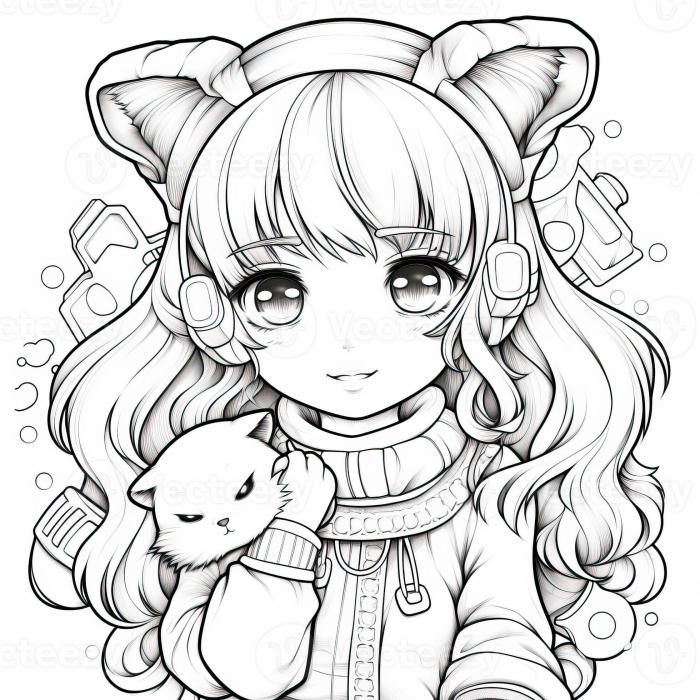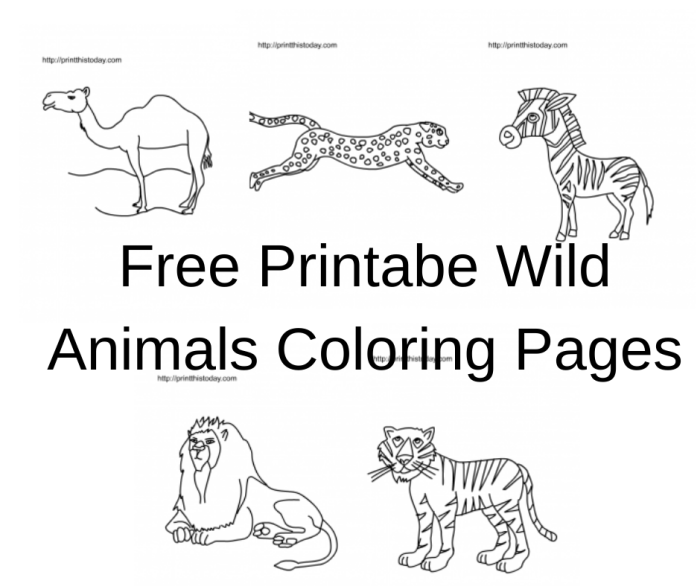Popularity and Trends of Anime Drawings Coloring Pages

Anime drawings coloring page – Anime-themed coloring pages have experienced a significant surge in popularity across various demographics, driven by the global appeal of anime and manga culture. This trend reflects not only the enduring fascination with Japanese animation but also the therapeutic and creative benefits associated with coloring activities.
The popularity of anime coloring pages spans a wide age range. Younger children are drawn to the bright colors and simple designs of popular characters, while teenagers and adults appreciate the intricate details and stylistic nuances found in more complex designs. The accessibility of digital coloring pages and printable resources further contributes to this widespread appeal, making them readily available to a diverse audience.
Anime drawings coloring pages offer a fantastic way to explore creativity and artistic expression. A particularly interesting variation on this theme involves celebrity likenesses, and you can find some great examples if you’re looking for something specific, like anime coloring pages zendaya. This allows you to combine your love of anime art style with your appreciation for a particular celebrity.
Ultimately, the world of anime drawings coloring pages is vast and offers endless possibilities for artistic exploration.
Popular Anime Styles in Coloring Pages
The most popular anime styles represented in coloring pages often mirror current trends in anime and manga itself. Styles such as “kawaii” (cute) characters with large eyes and simplified features remain consistently popular, particularly for younger audiences. Conversely, more mature audiences often gravitate towards coloring pages featuring characters from action-packed anime series, showcasing dynamic poses and intricate details.
The “shojo” (girls’ manga) style, characterized by romantic storylines and beautiful characters, also maintains a strong presence in coloring page designs. Finally, the increasingly popular “isekai” genre, featuring characters transported to fantasy worlds, is also reflected in coloring page designs, offering opportunities for vibrant and imaginative color palettes.
Trends in Anime Coloring Page Designs (Past Five Years)
Over the past five years, there has been a noticeable shift in the complexity and style of anime coloring pages. Initially, simpler designs dominated, focusing on single characters with minimal background details. However, a growing demand for more intricate designs has led to an increase in coloring pages featuring complex backgrounds, multiple characters interacting, and detailed environments. This trend mirrors the increasing sophistication and visual richness found in modern anime productions.
Furthermore, the integration of digital tools and techniques has allowed for more detailed line art and a wider range of color palettes, enhancing the overall aesthetic appeal of these coloring pages. For example, the availability of high-resolution digital coloring pages allows for greater detail and precision in the coloring process.
Evolution of Anime Coloring Page Complexity
The evolution of anime coloring page complexity is directly related to the evolving artistic skills and preferences of both creators and consumers. Initially, simple line drawings of iconic anime characters, often featuring bold Artikels and minimal detail, were prevalent. These were ideal for younger children or those new to coloring. However, in recent years, there’s been a marked increase in the complexity of designs.
Intricate linework, detailed backgrounds, and the inclusion of multiple characters and elements have become more common. This rise in complexity reflects a desire for a more challenging and rewarding coloring experience, appealing to adults and experienced colorists who appreciate the nuanced details and potential for creative expression. The availability of digital tools has also played a significant role, allowing artists to create highly detailed designs that would be difficult to achieve through traditional methods.
Target Audience and User Preferences

Anime coloring pages cater to a diverse audience, primarily driven by a shared appreciation for anime and manga aesthetics. Understanding the user base is crucial for designing effective and appealing coloring pages that resonate with their preferences and skill levels. This involves analyzing demographics, interests, and artistic inclinations.The typical user of anime coloring pages exhibits a wide range of characteristics, encompassing age, artistic skill, and engagement level.
User Demographics and Interests
The primary users are often young adults and teenagers, particularly females, though a significant portion of the audience also includes children and adult enthusiasts. Many are already fans of specific anime series or characters, actively seeking coloring pages featuring their favorites. This inherent connection to existing franchises and characters significantly impacts design choices. For example, a coloring page featuring a popular character from a currently trending anime will likely garner more interest than one featuring a lesser-known character from an older series.
The preference for specific genres, such as magical girl anime, shonen action series, or isekai adventures, also strongly influences the appeal of coloring pages.
Preferred Anime Characters and Themes
Popular anime characters frequently appearing in coloring pages include those from widely recognized series like “My Hero Academia,” “Demon Slayer,” “Attack on Titan,” and “Naruto.” The characters’ visual appeal, including distinctive hairstyles, clothing, and weaponry, contributes significantly to their popularity as coloring page subjects. Themes found in coloring pages often reflect the source material, such as epic battles, magical transformations, or heartwarming moments between characters.
For instance, a page featuring a dynamic battle scene from “Demon Slayer” would appeal to fans of action, while a calmer scene of friendship from “My Neighbor Totoro” would attract a different audience. Specific character archetypes, like stoic heroes, cute mascots, or elegant villains, also tend to be favored.
Age and Coloring Page Complexity
The relationship between age and preferred complexity is directly proportional. Younger children (ages 4-7) generally prefer simpler designs with larger areas to color and fewer intricate details. Older children (ages 8-12) and teenagers tend to gravitate toward more complex designs with smaller details and potentially more challenging shading requirements. Adults often enjoy intricate designs, requiring fine motor skills and attention to detail, allowing for more creative expression.
For example, a page with simple Artikels of large, recognizable characters would be suitable for younger children, while a page with detailed character portraits or complex backgrounds would appeal more to older children and adults.
Categorization of Preferences
User preferences can be broadly categorized into several key aspects:
- Character Type: This encompasses the character’s personality (e.g., cute, fierce, mysterious), role (e.g., protagonist, antagonist, supporting character), and visual style (e.g., realistic, chibi, stylized).
- Color Palette: The preference for specific color schemes varies greatly, with some users favoring vibrant and bold colors, while others prefer softer, more pastel tones. The color palette often aligns with the anime’s overall aesthetic.
- Style: This refers to the artistic style of the coloring page itself, ranging from simple line art to more intricate and detailed designs. The style choice often mirrors the style of the original anime.
Design and Artistic Elements: Anime Drawings Coloring Page

Anime coloring pages leverage distinct artistic elements to create engaging and visually appealing designs. The success of these pages hinges on a careful balance of line art, shading techniques, and overall composition, all tailored to the specific anime style being represented. Understanding these elements is crucial for both creating and appreciating the aesthetic appeal of these coloring pages.
Common design elements in popular anime coloring pages include clean, bold line art that defines character shapes and features. This line art often varies in weight, creating depth and emphasis on certain areas. Shading styles range from simple cell-shading, using flat blocks of color, to more complex techniques involving gradients, cross-hatching, and stippling to mimic light and shadow.
The choice of shading style significantly impacts the final look of the coloring page, influencing the overall mood and complexity.
Anime Coloring Page Formats
Anime coloring pages are available in various formats, catering to different skill levels and preferences. Single-character pages focus on a single anime character, providing a detailed illustration for coloring. Scene-based pages depict a complete scene from an anime, including multiple characters and background elements, offering a more complex coloring experience. Full-page designs utilize the entire page for a large-scale illustration, often featuring expansive backgrounds or multiple characters interacting.
These varied formats offer diverse levels of challenge and visual interest for colorists.
Comparison of Anime Art Styles in Coloring Pages
The table below illustrates the diverse range of anime art styles frequently adapted for coloring pages. Each style possesses unique characteristics that impact the coloring page’s complexity and overall aesthetic.
| Style | Characteristics | Example Characters | Coloring Page Complexity |
|---|---|---|---|
| Shojo | Large eyes, delicate features, flowing lines, pastel color palettes. | Sailor Moon, Cardcaptor Sakura | Moderate; focus on detail in eyes and hair. |
| Shonen | Dynamic poses, muscular builds, sharp lines, bold colors. | Goku (Dragon Ball), Naruto Uzumaki | High; intricate details in clothing and muscle definition. |
| Mecha | Detailed robots and vehicles, mechanical parts, metallic textures. | Gundam, Evangelion Units | Very High; requires precise coloring and shading of complex machinery. |
| Cute/Kawaii | Exaggerated features, large heads, round bodies, bright colors. | Hello Kitty, Rilakkuma | Low to Moderate; simple shapes and limited detail. |
Line Weight and Detail’s Impact on Aesthetics, Anime drawings coloring page
Line weight plays a crucial role in the aesthetic appeal of an anime coloring page. Thicker lines provide a bolder, more defined look, often used for Artikels and prominent features. Thinner lines add subtlety and detail, enhancing the character’s features and creating a sense of depth. Similarly, the level of detail influences the overall aesthetic. Highly detailed pages require more time and precision for coloring, but reward the colorist with a rich and satisfying final product.
A page with minimal detail offers a simpler, quicker coloring experience, perfect for beginners. The balance between line weight and detail directly affects the perceived complexity and visual impact of the final colored artwork. For instance, a character with heavily inked lines and intricate clothing patterns will appear more complex and detailed than a character with thinner lines and simpler clothing.

